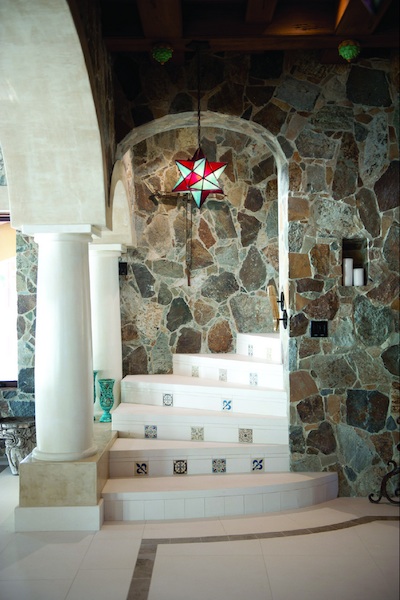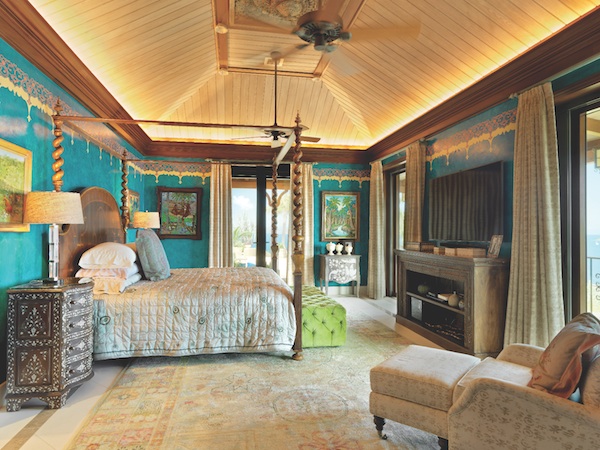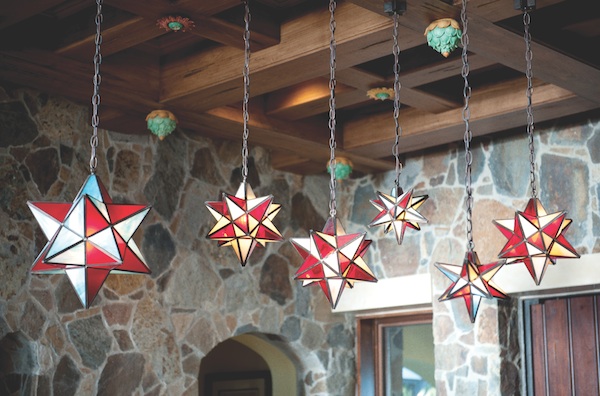
With design outposts in Los Angeles and Palm Desert, Nicholas Hertneck and Lawrence Lazzaro of Nicholas Lawrence Design are more than accustomed to zipping across Southern California between their offices and clients’ homes.
But when a 12-time, VIP client enlisted them to create the ultimate vacation getaway some 3,000 miles away, the two discovered new meaning behind the word “commute.”
Over the course of nearly eight years, the pair constructed, designed, and customized this captivating 10,800-square-foot estate, deftly built from the ground up to look as if it had been there for ages — rustic patina and all. Their dedication in traveling back and forth from the British Virgin Islands paid off — as did the dedication of a select group of Coachella Valley artisans whose meticulous craftsmanship throughout this world-class property serves as a tangible testament to the value of their skills.
Eight of the desert’s top artisans flew in to live and work on-site for one week; a team of three stayed on for a month to complete custom finishes, including elaborate stencil work and Venetian plaster. “Working with all of them, we were able to be more fanciful in our design and more daring in what we tried,” Lazzaro relates. “In the end, we could achieve exactly what we had in mind.”

photo by susan teare
In the entry hall, the star-shaped custom light fixtures and coffered ceiling were made in California and painstakingly imported. "We are very hands-on with our custom work," Lawrence Lazzaro says. "These skilled artisans help us achieve exactly what we have in mind."
Additionally, countless facets of this beach retreat were imported from our valley to this fairly remote destination. From the stone countertops and the handcrafted entry doors and gates to the Venetian plaster wall finishes throughout the master suite, the labors of love from these capable workers add untold depth to a home that occupies a prominent geographical feature — and endeavors to overpower its location’s reputation with beauty and artistic detail.
Truth be told, this yacht-stopping residence on the island of Virgin Gorda commands a promontory over a notoriously rocky harbor entrance. The locals have nicknamed this outcropping “Collision Point” (but use their vernacular spelling of “Colison”) for its infamous magnetism as the site of numerous shipwrecks. Yet the project actually symbolizes incredible harmony in a collision of two trends: designers as builders and the importation of Coachella Valley materials, product, and talent to get the job done right.
Originally, the pair were simply designers on the project, as the home’s construction kicked off with a British Virgin Islands–based architect. A year into construction, however, he up and left after pouring the foundation, taking his workers with him. Without hesitation, Hertneck and Lazzaro swiftly took over the architecture and construction management. Though the stakes were high on this $30 million investment, after 17 years of working with their client, he trusted them to soar beyond their traditional design roles.
For some of the estate’s most important details, they made a few calls back to the valley. “Fortunately, we have long-lasting relationships with these artisans that span back 20 years in some cases,” says Hertneck. “We trust them, we like working with them, and we can visit their workrooms to inspect and ensure everything is handcrafted to our custom specifications.”
Hertneck adds that they “had a huge education on containering things properly, receiving them overseas, storing them until we were ready to use them, the changing rules of homeland security, and even navigating warranties for appliances installed outside the U.S.”

photo by susan teare
Coachella Valley artisans spent 30 days on-site creating finishes such as the deep blue-green Venetian plaster walls in the master bedroom. The vibrant hue showcases a collection of works by Caribbean artists and contrasts with a neutral carpet made from reclaimed silk saris.
Today, proving it has more than a pretty face, the highly efficient home optimizes its resources to compensate for the island’s high costs for water and electricity.
“Through the process, we got our feet wet in the Caribbean, which has led to more design-build projects,” says Hertneck. It’s a trend the team sees as emerging, especially among clients who have established a rapport with their designers. While an engineer eventually checks for structural issues and stamps it for planning, the design firm acts as architects and oversees the construction before stepping back into the home’s final design.
At times, says the pair, they experienced the high-drama makings of a reality TV show, from the logistics of island travel, which Hertneck says “can feel like being in The Great Race” to cement trucks falling off cliffs into the ocean and local construction workers showing up barefoot.
The big payoff? “Our clients told us that the entire home felt familiar to them within a few hours,” beams Hertneck. “They spend much more time there than they had ever anticipated they would — more than at any of their other residences.”
What’s more, he adds, they built a home that not only “looks like it has been there forever” but one that will age gracefully in the rough environment of heat, sun, and salty air. In a twist of this home’s fate, the time-tested craftsmanship of the Coachella Valley desert is poised to withstand the divergent elements of living along the ocean’s edge.
Made in the Coachella Valley
Local workmanship completes this tropical estate.
1

photo by susan teare
The front gate and the custom mahogany entry doors — mounted with branches of hammered copper with a patina, which serve as door handles — were made locally.
2

photo by susan teare
In the entryway, the coffered mahogany and cedar ceiling, customized LED star lanterns, mosaic fountain, and elaborate swing with hammered metal from Morocco were all made locally.
3

photo by susan teare
In the kitchen, the millwork was done in the Coachella Valley. The stone slabs used for countertops and for thresholds throughout the home were also sourced and fabricated in the Coachella Valley before the fabricator traveled to the site to install them.
4
The ironwork for the home’s fanciful custom railings was custom-made by a Yucca Valley blacksmith.
5
The Venetian plaster and stencil artisans who live in the Coachella Valley traveled to the site for 30 days to add elaborate finishes to the master bedroom, bath, and guest suite.